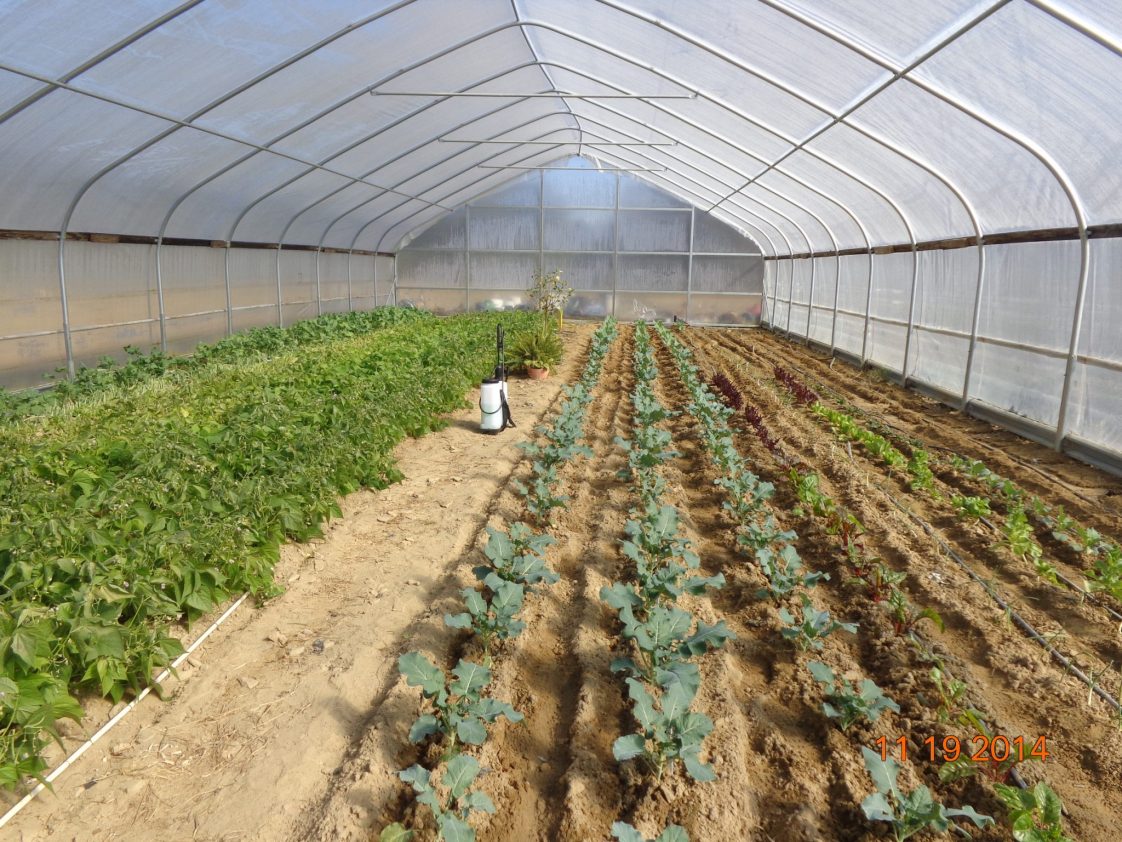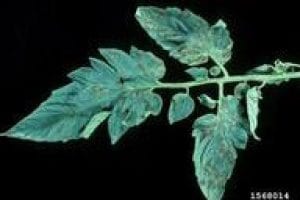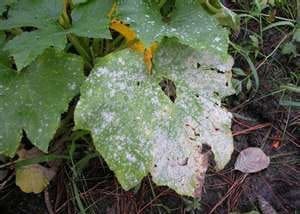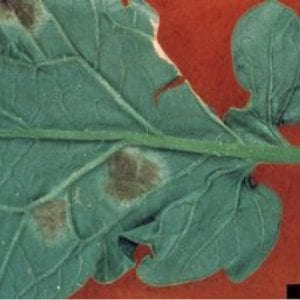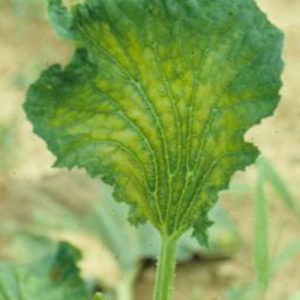Farming

The controlled environment in high tunnel systems is variable and requires daily inputs and planning during construction to effectively control plant disease.
In recent years, high tunnel production of vegetables has increased significantly in the Southeast. High tunnels provide crop protection from low temperatures in spring and fall, extending the growing season. Disease management practices in high tunnels are similar to those used in greenhouse production with a few notable differences. High tunnels and greenhouses are controlled environments but, unlike greenhouses, the high tunnel environment is more variable, requiring more daily inputs and more planning during construction.
In high tunnels, plant diseases common in field production are less of a concern, partly because of physical exclusion from some airborne pathogens; environmental conditions conducive to infection and establishment of many pathogens are not consistently present in high tunnels. Most fungal and bacterial pathogens require the presence of moisture over a certain period of time to infect a plant; this is less likely to occur when proper management practices are followed. Vegetable production in a high tunnel may result in lower incidence of diseases spread by rainfall and splashing water, such as bacterial spot of tomato and pepper (Xanthomonas campestris pv. vesicatoria). Diseases common to high tunnels, such as leaf mold (Fulvia fulva), Botrytis gray mold (Botrytis cinerea), and powdery mildew (Oidium, Podosphaera, Erysiphe, etc.), require high humidity for development. Consider the following factors when planning construction of high tunnel structures and managing plant diseases.
Proper Placement of Structure
Proper placement of the high tunnel structure is critical to ensure adequate sunlight and wind movement. Selection of a site should provide increased exposure to sunlight by avoiding shadows from trees, buildings, and adjacent high tunnels. Single-bay high tunnels should be positioned perpendicular to prevailing winds; structures with roll-up sides and multibay high tunnels should be situated parallel to prevailing winds to ensure maximum air flow. Increased air movement reduces humidity and minimizes conditions favorable to disease development. Raising and lowering the sides to vent tunnels allows a grower to manipulate temperature, moisture, and humidity, reducing diseases such as Botrytis that thrive under humid conditions.
Optimum Growing Conditions
Maintenance of optimum crop growth may be achieved by providing appropriate levels of nutrients and consistent soil moisture, allowing vigorous plant growth and minimizing disease development. Excessive fertilizer use provides overly rich soils and should be avoided. Overfertilizing may lead to rank plant growth, thereby reducing air movement and increasing humidity and moisture retention within the plant canopy. These conditions favor development of plant diseases. Fertilize plants only according to soil test recommendations.
Disease-Resistant Varieties
Disease-resistant varieties that are adapted to your climate should always be considered. Sources of information on resistant varieties for your area can be found at www.thegrower.com/south-east-vegetable-guide/.
Disease-Free Seed and Transplants
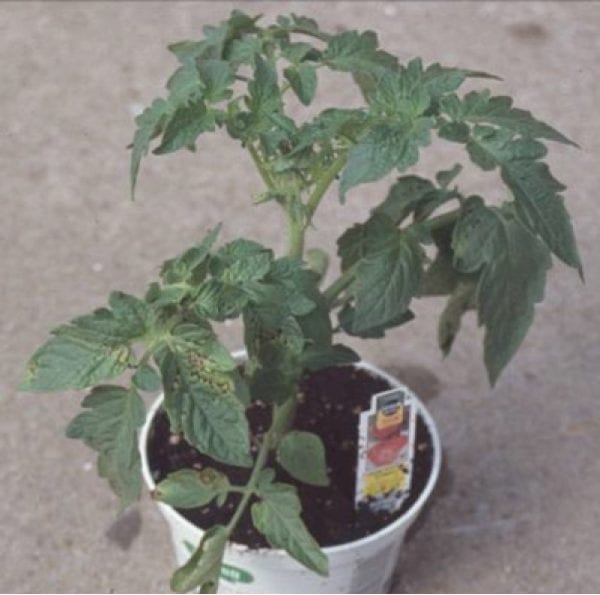
Figure 1. Tomato transplant infected with bacterial spot.
Seed can carry bacterial, fungal, and viral pathogens, so always start with disease-free seed or transplants purchased from a reputable dealer (figure 1). Alternately, treat seed prior to planting to reduce the risk of introducing pathogens that can establish and spread through the high tunnel.
Crop Rotation
The buildup of soilborne pathogens, which can be the hardest problem to avoid in high tunnel systems, can be reduced by the rotation of areas between crop families. Consider dividing the tunnel into a number of distinct areas; identify the crops to be grown and keep plants of the same family together in one area. Members of any given family should not be grown in the same spot for more than one year. For maximum impact, rotations should be maintained for at least three years, which is the time it takes for most soilborne diseases to decline below damaging levels.
Benefits of crop rotation are limited if only one structure is available for production; rotation of crops between structures is feasible if several high tunnel units are to be used. If soilborne diseases become a significant problem, temporary high tunnels can be built and moved to another location. It should be noted, however, that the relocation of tunnels takes advanced planning and increases costs.
If soilborne pathogens reach damaging levels, crop rotation may be an option, and it may be necessary to consider soil fumigants. Grafting onto resistant rootstock, commonly used for solanaceous and cucurbitaceous crops, may also be an effective practice.
Sanitation
Proper sanitation is critical for success in a high tunnel system. At the end of the growing period, all plant material, including the roots, should be removed and diseased plant tissue should be destroyed by composting, burying, or burning. When composting, cull piles should be located as far away from the high tunnel as possible, and a process that facilitates rapid decomposition and maintains the necessary high temperatures throughout the pile should be followed.
Weeds should be removed from inside the tunnel and the exterior as they may harbor insect pests and pathogens and reduce air movement. Aphids and thrips, for example, are harbored by weeds and act as vectors for viral diseases such as cucumber mosaic virus and tomato spotted wilt virus (TSWV). Additionally, some weed species may act as hosts to fungal diseases such as powdery mildew and downy mildew. Good weed control and elimination of volunteer plants within the structure limits survival of these types of pathogens and reduces disease inoculum in the area.
Surfaces, pruning tools, and knives should be cleaned and disinfected carefully on a regular basis, as well as after cutting or pruning, to reduce the risk of spreading disease. Similarly, workers should practice careful handling techniques such as washing hands at the end of each row and avoiding handling plants when free moisture is present. This minimizes the spread of pathogens, such as bacterial canker and tobacco mosaic virus (TMV), from diseased to healthy plants. Workers who smoke should dip their hands into whole milk followed by thorough washing in hot, soapy water to inactivate TMV, which may infect tomatoes. High tunnel personnel should avoid moving between high tunnels and field production areas with contaminated clothes or footwear, and clothing should be laundered often and stored in a smoke-free facility.
Environmental Management
For optimum disease control in high tunnels, proper management of temperature and humidity must be a priority. High relative humidity (above 90 percent) is particularly favorable to the development of foliar fungal diseases, such as leaf mold of tomato and Botrytis gray mold, and should be limited. Providing wider plant spacing by reducing plant populations, encouraging good air flow by providing high tunnel ventilation, and avoiding excessive shading within the planting reduce the risk of disease. Wet soils promote the development of soilborne pathogens so it is necessary to avoid overhead irrigation and provide adequate drainage within the high tunnel, keeping the foliage as dry as possible.
Scouting for Disease
Proper diagnosis of a disease or disorder is vital in the determination of the best method of control; weekly scouting of a crop enables operators to recognize and react to developing problems more quickly if they know where to look. Foliar diseases usually start in the lower canopy where air flow is limited and then spread upward. Root and crown diseases often begin in areas of the structure where drainage is poor. Once identified, fungicides may be recommended for disease control. However, a “one fungicide beats all” approach will often fail because fungicides tend toward specificity for a particular pathogen. For proper diagnosis, contact your regional Extension agent or submit a sample to your local Plant Diagnostic Lab.
Fungicides
Preventive spray programs require following a regular schedule when conditions favor disease development because plant diseases are difficult to manage once they become established in a high tunnel system. Before applying any pest control product, make sure to read and understand the safety precautions and application restrictions. Be certain the label indicates that the chemical is safe to use in a high tunnel system. Adequate spray coverage is essential for disease control, and lack of good coverage often leads to disease outbreaks.
Use of crop rotation, sanitation, and clean plant materials will minimize the risk of soilborne diseases. Unfortunately, it is not always possible to keep all pathogens out of a structure, and soilborne diseases can be especially difficult to control once established in a high tunnel system. Options to control soilborne pathogens include the use of soil fumigants, soil solarization, and root grafting. In severe cases, relocation of the high tunnel may be the only option.
Common Diseases and Management Practices for High Tunnel Production
Tobacco Mosaic Virus (TMV)
TMV can be a problem when resistant varieties are not used and frequent handling of plants occurs. TMV can be a severe problem in high tunnel systems because it is readily spread by human activities. Handling plants during standard production practices, such as transplanting, tying, and pruning, can effectively spread the virus.
Infected leaves, root debris, and seeds are common sources of TMV. Symptoms appear as light and dark green mottled areas on leaves. Leaves on infected plants are often small, curled, and puckered. Plants infected early in their development are stunted and have a yellowish cast. TMV can reduce the size and number of fruit produced. Symptoms may vary depending on virus strain, time of infection, variety, and environmental conditions. Control practices should begin before planting. Eradicate weeds from the structure and surrounding areas. Continue weed control during and after the growing season. Use TMV-resistant varieties when feasible. Make sure that transplants are healthy and certified as disease free. Discourage use of tobacco by workers, and encourage the practice of washing hands with soap and water before and after handling plants. Destroy infected plants found at transplanting and during the season.
Tomato Spotted Wilt Virus (TSWV)
TSWV is a disease of tomatoes that is spread primarily by thrips. Preventing virus transmission by controlling thrips is difficult because the insect can transmit the virus within minutes of active feeding. Thrips and TSWV occur in numerous weed hosts,
which allow the disease to survive in an area from year to year. Tomato plants infected with TSWV become stunted and often die. Initially, leaves in the terminal portion of the plant stop growing, become distorted, and turn pale green. In young leaves, veins thicken and turn purple, causing the leaves to appear bronze (figure 2). Infected fruit may exhibit ring spots and blotches and may become distorted if infected when immature (figure 3).
The primary tactic to manage TSWV is the use of resistant tomato varieties (http://www.thegrower.com/south-east-vegetable-guide/). Controlling weeds adjacent to the high tunnel will reduce the thrips population and virus inoculum prior to planting.
- Figure 2. Bronzing of leaf typical of tomato spotted wilt virus infection in tomato.
- Figure 3. Tomato spotted wilt virus– infected fruit may exhibit ring spots and blotches
- Figure 4. Leaves infected with powdery mildew can become covered with a superficial, powdery, white fungal growth.
Powdery Mildew
Powdery mildew is a common problem in Alabama on field-grown cucurbits, and it poses a greater risk to vegetables, including tomatoes, grown in high tunnels. The fungal disease first appears as pale, yellow spots on stems, petioles, and leaves. These spots expand, merge, and become covered with a superficial, powdery, white fungal growth (figure 4). Severely infected leaves gradually turn yellow, wither, and die. Powdery mildew can overwinter on weeds around high tunnels, and air currents can carry spores of the fungus long distances into an area. The disease is favored by dry plant surfaces, high humidity, moderate-to-high temperatures, low-light intensity, and excessive plant growth. The principal control measures for powdery mildew are the use of resistant varieties and timely fungicide applications.
Thorough coverage of the foliage is essential for good control and requires the fungicide to reach the underside of leaves. Weed control and good sanitation practices may help limit powdery mildew.
Leaf Mold
Leaf mold, a fungal disease, is primarily a problem on high tunnel and greenhouse-grown tomatoes. The disease is most destructive when the relative humidity in the structure is too high (above 85 percent). Under these conditions, the fungus develops rapidly on foliage, usually starting on the lower leaves and progressing upward. If leaf mold is not controlled, large portions of the foliage can be killed, resulting in significant yield reductions.
Symptoms first appear as small, pale green or yellowish spots on the upper leaf surface. The fungus appears on the corresponding lower leaf surface as an olive green to grayish purple velvety growth (figure 5), composed mostly of spores of the pathogen. Infected leaves become yellowish brown, curl, and drop prematurely. Fruit infections appear as a black, leathery, stem-end rot, which can develop on both green and ripe tomato fruit with up to one-third of the fruit surface affected.
The fungus survives between seasons on plant debris, in seed, and in soil. Spores of the fungus have been reported to survive in greenhouses for one year in the absence of a host. Large numbers of spores are produced on the undersurface of infected leaves. These spores are easily spread from plant to plant by air currents and splashing water and on tools and clothing of workers. To control leaf mold, growers need to keep the relative humidity in a structure below 85 percent and keep free moisture from persisting on leaves. Providing good ventilation and as much light as possible will aid in this process. Keeping leaves dry when watering and providing adequate spacing to avoid excessive shading will aid in control of leaf mold.
- Figure 5. Leaf mold appears on the lower leaf surface as an olive green to grayish purple velvety growth.
- Figure 6. Virus symptoms may include leaf malformation, yellowing, or light green mottlling of the foliage.
Viral Diseases of Cucurbits
Viral diseases are a major problem of cucurbits in Alabama. Zucchini yellow mosaic virus (ZYMV), cucumber mosaic virus (CMV), papaya ring spot virus (PRSV), and watermelon mosaic virus (WMV) are aphid-transmitted viruses. Management of the insect vector is extremely difficult and has not been a successful way to control these diseases. Symptoms vary depending on the host and plant age at the time of infection but may include stunting, leaf malformation, and yellowing or light green mottling of the foliage (figure 6). Plants infected when young produce few marketable fruit. The most effective control of these diseases is the use of virus-resistant varieties.
Download a PDF of Disease Management in High Tunnel Systems, ANR-2393.

